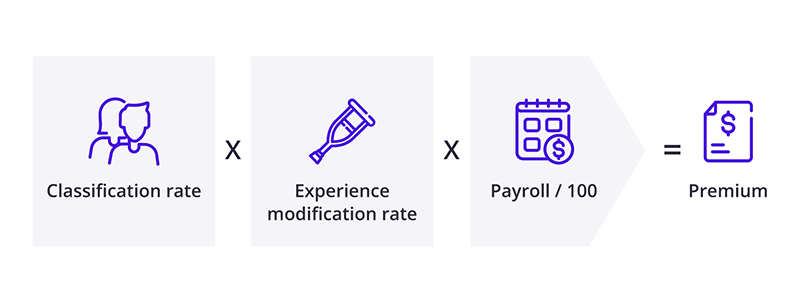
Workers' compensation insurance for healthcare workers and providers
Workers’ compensation insurance
Workers’ compensation insurance covers medical costs and lost wages for work-related injuries and illnesses. This policy is required in almost every state for businesses that have employees.
Workers’ comp insurance protects workers at your healthcare clinic
Even if you take steps to ensure a safe work environment, you can’t prevent every accident. From carpal tunnel syndrome to a needlestick injury that transmits hepatitis, an injury or illness can be financially disastrous for a small healthcare company.
Workers’ comp insurance can pay for medical bills and partial missed wages while an employee is recuperating. Most states require this coverage for businesses with employees.
Workers’ compensation can help pay for an injured employee’s:
- Immediate medical costs, such as an ambulance ride
- Ongoing medical costs, such as medication
- Partial lost wages while the employee is recovering
- Disability benefits for lasting injuries
Workers’ compensation protects healthcare business owners
Usually included in a workers’ comp policy, employer’s liability insurance provides protection when a staff member decides to sue their employer over an injury.
Employer’s liability insurance can help pay for:
- Court costs
- Attorney’s fees
- Settlements
Without adequate coverage, you could find yourself paying for a costly legal defense, even if a lawsuit is frivolous.
How are workers' compensation costs calculated?
The amount you pay for workers’ compensation insurance is a specific rate based on every $100 of your business’s payroll. Your premium is determined by the type of work done by your employees (classification rate), your experience modification rate (claims history), and your payroll (per $100).
The formula providers use in underwriting to calculate workers' comp rates is:

State laws set workers’ comp requirements for healthcare professionals
Every state creates its own laws for workers’ compensation requirements. For example, every healthcare business in Minnesota must carry workers’ compensation insurance for its employees – even part-time workers. However, Alabama healthcare companies are only required to carry workers’ compensation when they have five or more employees.
While independent contractors, sole proprietors, and partners don’t have to carry workers’ compensation insurance, you can purchase a policy to protect yourself, too. It's a good idea to carry this coverage for financial protection against work injuries, which health insurance might not cover.
Workers' compensation laws in your state

Monopolistic state funds for workers’ compensation
In certain states, healthcare professionals must purchase coverage through a monopolistic workers' comp state fund. Those states are:
If you purchase workers’ comp through a monopolistic state fund, it might not include employer’s liability insurance. However, you can purchase it as stop gap coverage from a private insurance company.

Lower workers’ comp costs with risk management
Healthcare professionals face tremendous risks: back injuries from moving and lifting patients, infections from contaminated needles, and repetitive motion injuries. Owners of medical practices can help reduce risks with:
- Employee safety training
- Proper equipment, such as gloves and surgical masks
- Medical equipment maintenance
- Prompt disposal of contaminated items, such as used needles
By implementing a risk management plan and maintaining a safe work environment, you can limit workplace accidents. That means fewer claims – and a lower insurance premium.
How much does workers' comp for healthcare professionals cost?

Healthcare businesses pay an average of about $60 per month for workers' comp, but you could pay more or less depending on your risks.
Insurance costs for healthcare professionals are based on a few factors, including:
- Healthcare services offered, such as dentistry or hospice care
- Medical equipment and other business property
- Revenue
- Location
- Number of employees
Other key policies for healthcare professionals
Workers’ compensation insurance protects your employees and to some extent your business, but it doesn’t cover common risks such as property damage and customer injuries. Other recommended insurance policies for healthcare professionals include:
General liability insurance: This policy can pay legal expenses related to patient property damage and injuries, such as a patient who trips in your office and breaks a wrist.
Business owner’s policy: A BOP bundles general liability coverage with commercial property insurance, often at a lower rate than if the policies were purchased separately.
Professional liability / medical malpractice insurance: This policy helps pay for legal expenses when a healthcare professional is accused of negligence or an error that harms a patient.
Commercial auto insurance: State laws require this coverage for vehicles owned by a business. It helps cover the cost of an accident involving a business vehicle.
Cyber liability insurance: This policy helps healthcare professionals survive data breaches and cyberattacks by paying for recovery expenses and other associated costs.
Get free quotes and buy online with Insureon
Are you ready to safeguard your healthcare practice with workers' compensation or another type of insurance? Complete Insureon’s easy online application today. Once you find the right policy, you can begin coverage in less than 24 hours.
Verified workers' compensation insurance reviews

Want free expert advice right in your inbox?
By entering your email address and subscribing, you agree to our Terms of Use and Privacy Policy
























